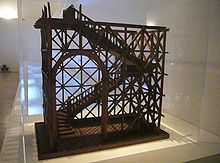
Back منشآت مقاومة للزلازل Arabic Maavärinakindlad konstruktsioonid ET سازههای مقاوم در برابر زمینلرزه FA 耐震 Japanese 내진설계 Korean Depreme dayanıklı yapılar Turkish Сейсмостійкі конструкції Ukrainian

Earthquake-resistant or aseismic structures are designed to protect buildings to some or greater extent from earthquakes. While no structure can be entirely impervious to earthquake damage, the goal of earthquake engineering is to erect structures that fare better during seismic activity than their conventional counterparts. According to building codes, earthquake-resistant structures are intended to withstand the largest earthquake of a certain probability that is likely to occur at their location. This means the loss of life should be minimized by preventing collapse of the buildings for rare earthquakes while the loss of the functionality should be limited for more frequent ones.[1]
To combat earthquake destruction, the only method available to ancient architects was to build their landmark structures to last, often by making them excessively stiff and strong.
Currently, there are several design philosophies in earthquake engineering, making use of experimental results, computer simulations and observations from past earthquakes to offer the required performance for the seismic threat at the site of interest. These range from appropriately sizing the structure to be strong and ductile enough to survive the shaking with an acceptable damage, to equipping it with base isolation or using structural vibration control technologies to minimize any forces and deformations. While the former is the method typically applied in most earthquake-resistant structures, important facilities, landmarks and cultural heritage buildings use the more advanced (and expensive) techniques of isolation or control to survive strong shaking with minimal damage. Examples of such applications are the Cathedral of Our Lady of the Angels and the Acropolis Museum.[citation needed]
- ^ Seismology Committee (1999). Recommended Lateral Force Requirements and Commentary. Structural Engineers Association of California.